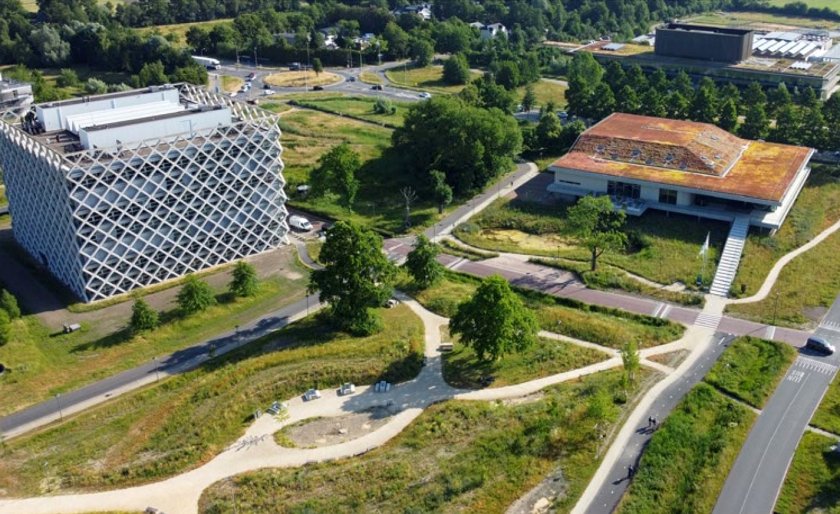
A sustainable campus is a green campus
Thousands of humans, animals and plants use the Wageningen University & Research terrain on Wageningen Campus every day. Park manager Elike Wijnheijmer of Facilities and Services tries to include all their interests in the design and management of the grounds. She collaborates with experts from Wageningen and her colleagues from Facilities and Services to make the greenery on campus as attractive as possible for both humans and animals.
Many spots on the WUR campus have a specific history. The way the green is designed has been carefully considered, such as in the case of the NL2120 landscape garden. This garden was constructed four years ago between the Atlas, Omnia and Orion buildings. NL2120 refers to the WUR project bearing the same name, which envisions a green, hopeful future for the way the Netherlands is designed one hundred years into the future. The garden is constructed according to the principles of nature-based solutions that also serve as a foundation for the map of the Netherlands for the future. The landscape garden goes from high and dry to low and wet. A wadi retains water for dry spells, and there are benches and a fountain, which is activated by cycling.
The garden is but a small plot within the larger landscape of the relatively young campus. The first design for the campus landscape dates from 2004 and is based on the surrounding cultural-historical agricultural region. It consisted mainly of grasslands and meadows, hedges and shrubs. Facilities and Services, together with users and WUR experts, has been working in recent years on increasing the variety. The landscape garden is a good example of this.

Green perspective
Wijnheijmer, who studied ecological horticulture in Wageningen and worked for Facilities and Services for many years, was first asked about afforestation on the campus in 2013. In the years that followed, she was increasingly called on for the greening of the campus. She also wrote the Green Perspective, which has been in effect since 2019. She strives towards a campus that is attractive for humans and animals.
In the centre of the campus, the green now comes in the form of a city park, while it aligns more with nature towards the fringes of the campus. ‘There are more people in the middle of the campus’, Wijnheijmer explains. ‘I sometimes hear requests for a forest of marsh in the middle of the campus. But where would those twenty thousand people go? Rewilding is great, but we must remain practical.’

Brochure: Discover Wageningen Campus
‘Discover Wageningen Campus' is a recently published brochure about the campus that is filled with information and tips on discovering the campus grounds. In addition to descriptions of unusual vegetation, the brochure highlights works of art and other extraordinary objects and spots worth visiting.
Violets
Practicality is also essential in the NL2120 landscape garden. The idea for this garden emerged in 2020 when two interns at the the landscape architecture department of Wageningen Environmental Research (WEnR) translated the NL2120 future perspective into a presentation for a garden festival. A great idea, she thought. Together, they searched a spot and altered the plan somewhat. ‘The plan included violets, for example. They won’t survive on the campus.’
The garden festival was cancelled due to the covid pandemic, but the plan for the campus remained intact. It was even expanded to include the entire field between the Orion and Atlas buildings. The interns conducted an area analysis and a design that aligns with the campus landscape, located between the Veluwe’s higher sandy soils and the wet, lower soils of the Gelderse Vallei. Wijnheijmer managed to secure funding for the construction and detailed the flower field. ‘Flower fields are never mown. As a result, they provide food from March well into November and provide critters and insects with shelter year-round.’
Discussing with WUR experts
Wijnheijmer and her colleagues at Facilities and Services collaborate as much as possible with researchers and involve WUR experts in detailing the plans. Ecologist Wieger Wamelink and landscape architect Bertram de Rooij are the dedicated sparring partners for the WUR Green Committee that Wiinheijmer initiated. ‘Additionally, I seek out other WUR experts for specific issues. For example, when we were able to plant some 250 trees in 2016, Wageningen University forest ecologist Leo Goudzwaard provided advice on what tree species to select. Leo even came to check the species authenticity and holes during the planting.’

Oak processionary
Not all of Wageningen’s knowledge can be directly applied, Wijnheijmer says. WUR is researching alternative oak processionary pest control methods, but has not yet implemented them on campus. ‘We can’t experiment with it, as it may imperil the health and safety of the people on the campus.’ She recommended selecting the most environmentally friendly method from the already proven methods.
Wijnheijmer could easily spend hours talking about making the campus more attractive for humans and animals. She wants to know how newly added vegetation contributes to the biodiversity among birds and insects. ‘This calls for expertise from various disciplines to gather data, analyse it, and translate it into planting and maintenance plans for the future. That would be a great challenge for the coming period.’
Sustainable management
WUR Facilities and Services employees detail how they contribute to sustainable operations in a series of interviews. In other words, WUR operates as sustainably and socially responsible as possible. Consider, for example, topics such as green on the campus, the energy transition, healthy and sustainable catering, sustainable IT and inclusiveness. Thus, WUR contributes to a habitable planet for all through its business management. More information and stories can be found on sustainable business operations.